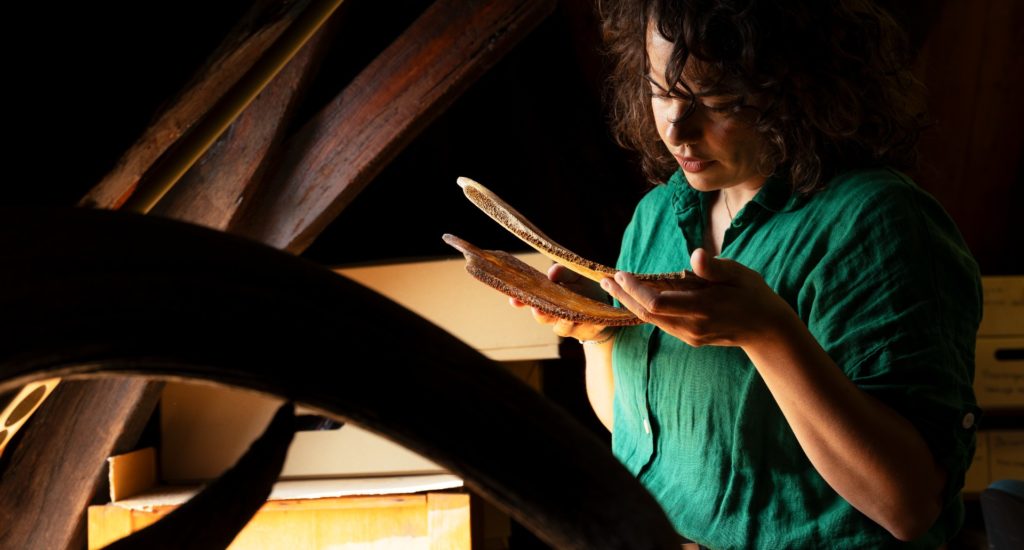Green turtles fed at same seagrass meadows 3,000 years ago

Willemien de Kock looking at sea turtle bones. Credit Leoni von Ristok
Green turtles today feed at the same seagrass meadows as their ancestors did about 3,000 years ago, new research shows.
The study combined modern tracking data with archaeological findings of turtle bones in the eastern Mediterranean.
With seagrass meadows now under threat due to climate change, the findings highlight the need to protect and monitor these precious habitats.
Led by historical ecologist Dr Willemien de Kock, from the University of Groningen, the research team also included the universities of Exeter, York and Copenhagen, and the Society for the Protection of Turtles (SPOT).
Along the coasts of the eastern Mediterranean, volunteers work to protect the nests of green sea turtles – a species listed as “endangered” globally on the IUCN Red List.
However, Dr De Kock said: “We currently spend a lot of effort protecting the babies but not the place where they spend most of their time: the seagrass meadows.”
Sea turtles migrate between specific breeding and feeding areas throughout their lives, and the study shows the long-term importance of seagrass meadows along the coast of North Africa.
University of Exeter scientists have collected long-term data on turtles nesting in Cyprus, which swim throughout the Eastern Mediterranean, using satellite tags and stable isotope analysis of tissues.
Professor Annette Broderick, from the Centre for Ecology and Conservation at Exeter’s Penryn Campus in Cornwall, said: “It is amazing that green turtles that currently nest in Cyprus are using the same seagrass habitats to forage as their ancestors did 3,000 years ago.
“This study highlights the importance of this critical habitat for green turtles and the need to protect existing seagrass beds and monitor how they are being impacted by rising sea temperatures to ensure that green turtles continue to live in the Mediterranean for another 3,000 years!”
Michelle Alexander, Professor of Bioarchaeology at the University of York, said: “This is a really nice example of archaeology providing a crucial window into the ecology and behaviour of animals in the past – key for informing on conservation strategies in the present.
“The fact that sea turtles have been using the same habitats for thousands of years is incredible.”
After green turtles hatch, they crawl to the ocean and spend several years floating before they are able to navigate. They eat a mixed diet in this period.
At about five years old, they swim to seagrass meadows and these become their main feeding habitat for the rest of their lives.
Past research has shown females repeated use the same seagrass beds year after year – and this may now put them in danger. Recent models have shown a high risk of widespread loss of seagrass in precisely the spots where green turtles have been going for millennia.
Picking through the bones
In the attic of the Groningen Institute of Archaeology at the University of Groningen, Dr De Kock had access to boxes full of sea turtle remains from archaeological sites in the Mediterranean Sea area.
The excavations had been done by her supervisor, Dr Canan Çakırlar.
Dr De Kock identified two species: green and loggerhead turtles.
By analysing the bone collagen with a mass spectrometer, Dr De Kock could detect what kind of plants the sea turtles must have eaten.
She explained: “For instance, one plant might contain more of the lighter carbon-12 than another plant, which contains more of the heavier carbon-13. Because carbon does not change when it is digested, we can detect what ratio of carbon is present in the bones and infer the diet from that.”
Combining old and new
Modern satellite tracking data from the University of Exeter then provided Dr De Kock with information on the current travelling routes and destinations of sea turtles.
Exeter researchers had also been taking tiny samples of sea turtles’ skin, which revealed similar dietary information as Dr De Kock found in bones.
Dr De Kock was therefore able to draw conclusions, connecting diets of long-dead turtles to specific locations.
She found that approximately 3,000 years ago, green sea turtles fed on sea grass meadows along the coasts of Egypt and West Libya.
The results for loggerhead turtles were less specific because they had a more varied diet.
“Even long-term data goes back only about 100 years,” said Dr De Kock.
“But tracing back further in time using archaeological data allows us to better see human-induced effects on the environment.”
The study, published in the journal Proceedings of the National Academy of Sciences, is entitled: “Threatened North African seagrass meadows have supported green turtle populations for millennia.”



